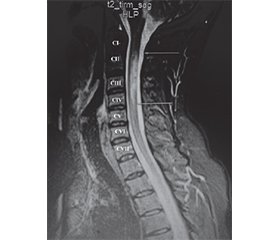Международный неврологический журнал Том 20, №5, 2024
Вернуться к номеру
Спектр оптикомієліт-асоційованих розладів. Клінічний випадок
Авторы: Боженко Н.Л., Негрич Т.І., Шоробура М.С., Малярська Н.В., Боженко М.І.
Львівський національний медичний університет імені Данила Галицького, м. Львів, Україна
Рубрики: Неврология
Разделы: Справочник специалиста
Версия для печати
Актуальність. Хвороби спектра оптикомієліт-асоційованих розладів (NMOSD) упродовж багатьох років маскувалися під іншими діагнозами. Сучасні діагностичні критерії розширюють можливості встановлення діагнозу, проте потребують апробації в умовах реальної клінічної практики. Мета: через розбір клінічного випадку та літературний пошук проаналізувати алгоритм встановлення діагнозу оптикомієліту на основі нової клінічної настанови «Діагностика та лікування спектру оптикомієліт-асоційованих розладів», розробленої в 2023 році в Україні, виділити маркерні ознаки, що виключають альтернативні діагнози, провести аналіз ефективності лікування пацієнта у динаміці. Матеріали та методи. Використали бібліосемантичний метод, методи системного та порівняльного аналізу. Подали результати власного клінічного досвіду, провели динамічний аналіз клінічного випадку хворого з оптикомієлітом. Результати. За останні 6 років у КНП ЛОР «Львівська обласна клінічна лікарня» були проліковані у неврологічному відділенні 23 хворі з діагнозом оптикомієліту. У 2018 році лише 1 пацієнт, 2019 — 5 хворих, 2020 — 3 хворі, 2021 — 6 осіб, 2022 — 8 пацієнтів. Розглянули клінічний випадок пацієнта 52 років, який звернувся по медичну допомогу на кафедру неврології ЛНМУ ім. Данила Галицького у 2023 році. Проаналізували шлях пацієнта з 2019 року з динамікою на МРТ до встановлення діагнозу оптикомієліту з врахуванням актуальних діагностичних критеріїв, у яких оптикомієліт було включено у склад єдиного терміна «NMOSD». Наявність навіть 1 із 6 основних клінічних проявів у поєднанні з наявністю AQP4-IgG дає підстави для встановлення діагнозу NMOSD. Провели диференційну діагностику з іншими патологіями, на основі цього виділено маркерні ознаки, що виключають розсіяний склероз, гострий розсіяний енцефаломієліт, інфекційні мієліти. Розглянуто діагностичні аспекти NMOSD та можливості лікування. Проведено аналіз ефективності лікування пацієнта в динаміці. Висновки. Нова українська клінічна настанова щодо оптикомієліт-асоційованих розладів, яка базується на міжнародних консенсусних діагностичних критеріях, поліпшує стандартизацію підходу до пацієнтів з NMOSD і може ефективно використовуватися в умовах реальної клінічної практики. У розглянутому нами клінічному випадку пацієнта, в якого наявний мієліт без невриту зорового нерва, саме наявність AQP4-IgG та ретельна дифдіагностика з іншими патологіями відіграє ключову роль у встановленні діагнозу.
Background. Neuromyelitis optica spectrum disorder (NMOSD) has been masked under other diagnoses for many years. Modern diagnostic criteria expand diagnosis possibilities, but they need approbation in real clinical practice. The purpose was through the analysis of a clinical case and literature search to analyze the algorithm for making a diagnosis of neuromyelitis optica based on the new clinical guideline “Diagnosis and treatment of the neuromyelitis optica spectrum disorders” developed in 2023 in Ukraine, to identify marker signs that exclude alternative diagnoses, to analyze the effectiveness of patient treatment in dynamics. Materials and methods. We used the bibliosemantic method, as well as methods of systematic and comparative analysis. We presented the results of our own clinical experience and conducted a dynamic analysis of a clinical case of neuromyelitis optica. Results. Over the past six years, 23 patients diagnosed with neuromyelitis optica were treated at the neurological department of the Lviv Regional Clinical Hospital: 1 patient in 2018, 5 in 2019, 3 in 2020, 6 in 2021, 8 in 2022. We examined the clinical case of a 52-year-old patient who sought medical help at the Department of Neurology of Danylo Halytskyi Lviv National Medical University in 2023. We analyzed the patient’s path to the diagnosis of neuromyelitis optica with the dynamics of changes on magnetic resonance imaging from 2019, considering current diagnostic criteria in which neuromyelitis optica was included in the single term NMOSD. The presence of even one of the six main clinical manifestations, in combination with the presence of AQP4-IgG, gives grounds for making a diagnosis of NMOSD. We carried out a differential diagnosis with other pathologies. Based on this, we identified marker signs to exclude multiple sclerosis, acute disseminated encephalomyelitis, infectious myelitis, and other diseases. Diagnostic aspects of NMOSD and treatment options were considered. An analysis of the effectiveness of the patient’s treatment in dynamics was carried out. Conclusions. The new Ukrainian clinical guideline for neuromyelitis optica spectrum disorder, which is based on international consensus diagnostic criteria, improves the standardization of the approach to patients with NMOSD and can be effectively used in real clinical practice. In our clinical case of a patient with myelitis without optic neuritis, the presence of AQP4-IgG and careful differential diagnosis with other pathologies play a key role in the diagnosing.
оптикомієліт-асоційовані розлади; оптикомієліт; диференційна діагностика; клінічний випадок; аквапорин-4; МРТ
neuromyelitis optica spectrum disorder; neuromyelitis optica; differential diagnosis; clinical case; aquaporin-4; magnetic resonance imaging

